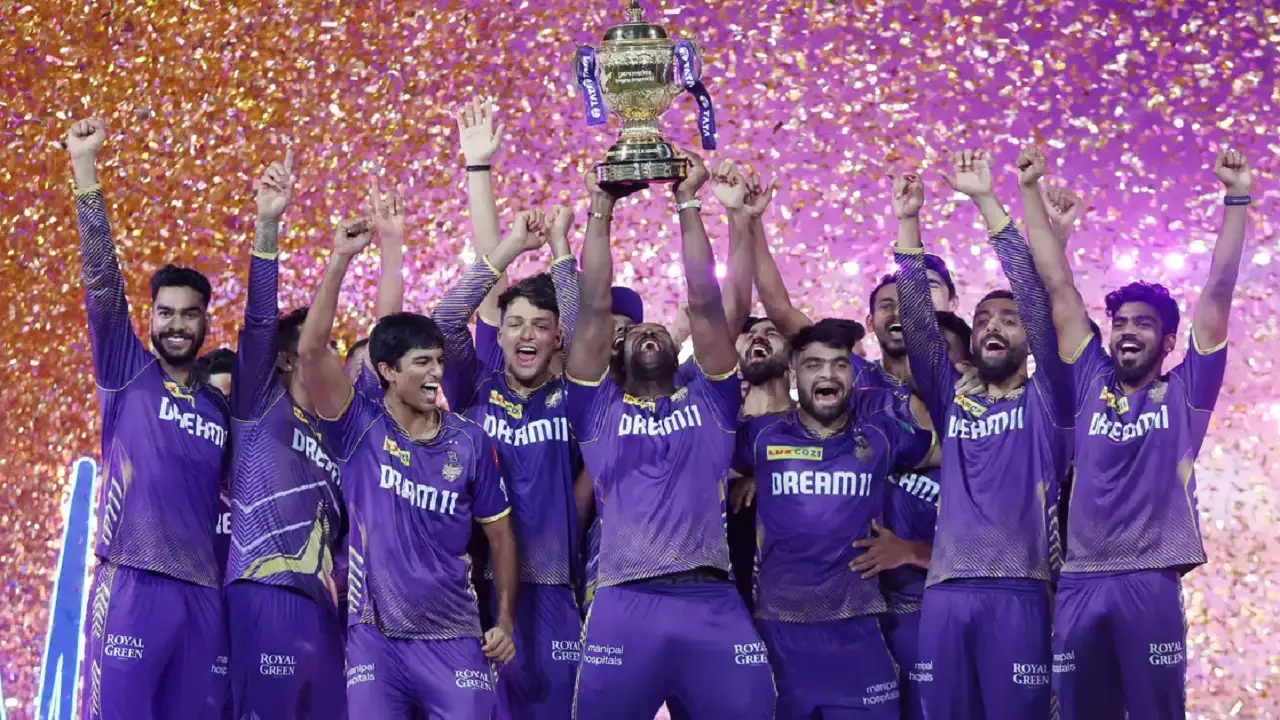Jarrod Kimber, Shayan Ahmad Khan
Kolkata Knight Riders won their third IPL title in what was arguably one of the most dominant seasons in the history of the league. Their last trophy had come in 2014, but Shreyas Iyer’s side ended a decade-long wait. KKR lost only three games throughout the competition, winning 11.
Why they reached the final:
Sunil Narine’s opening partnership with Phil Salt was pivotal to KKR’s success. Among opening pairs with at least 250 runs this season, they were the second-quickest with a run rate of 12.46 runs per over. They had a deep batting lineup, which allowed their top-order batters to attack with freedom.
KKR also had the likes of Shreyas Iyer and Venkatesh Iyer to steady the ship if the situation demanded, although Venkatesh (strike rate of 159), often batted with the same freedom in the middle order too, and very effectively at that. When KKR had a serious blip, their all-round depth saw them through. For instance, they were struggling at 57 for 5 against Mumbai Indians at the Wankhede Stadium when Venkatesh and Manish Pandey stitched together a crucial partnership of 83 runs. But importantly, they were willing to be flexible with their batting positions according to the match situation.
KKR had the best allround bowling attack in the league. They were the third-most economical bowling unit after Rajasthan Royals and Chennai Super Kings, but they took wickets a lot more frequently. In their last six innings, they took 57 wickets.
Vaibhav Arora and Mitchell Starc took powerplay wickets, while Varun Chakravarthy and Narine made it difficult for oppositions to attack them in the middle. Andre Russell kept taking game-changing wickets in the middle overs, and Harshit Rana did a superb job despite bowling a lot of difficult overs.
Who have been the stars:
Three of KKR’s overseas signings had an outstanding tournament, while the fourth (Starc) won the Player of the Match in both their playoff matches.
Narine now has a great case for having the best season by any player in IPL history. He scored 488 runs in 14 innings at an average of 34.85 and a strike rate of 180.74. He also took 17 wickets at an economy rate of 6.69. The true values suggest he had a batting strike rate of 32.56 more than expected, and he conceded 2.31 runs per over fewer than expected. That sort of outperformance in one discipline alone is stunning, and Narine did both.
His opening partner Salt scored 435 runs at an average of 39.54 and a strike rate of 182. His true average was 7.34, while his true strike rate was 35.11. As an opening pair, they were able to maximise their returns in the powerplay. And they did not slow down once the field restrictions were over either.
Coming into the tournament, Russell had been in exceptional batting form. But in this IPL, he had more of an impact with the ball. In fact, he has never taken more wickets in an IPL season. He took 19 at an economy of 10.06. His true economy was -0.61, so he was slightly more expensive than expected. But he took 1.37 wickets more per four over spell, which was the highest for any bowler that bowled at least 50 balls this season. He also scored 222 runs in nine innings at an average of 31.71 and at a strike rate of 185.
But it was not just about the big overseas players. KKR’s Indian core also did a brilliant job. Harshit was arguably the second-best Indian seamer in the league after Jasprit Bumrah. He showed some promise in the last season, but he really came into his own this time around. He picked up 19 wickets at an economy of 9.08. He had a true economy of 1.51 and he took 0.63 wickets more per four over spell.
Chakravarthy had a brilliant season too, but he was at his best in the second half of the tournament. In the first eight innings, he took eight wickets at an economy of 9.72. He followed it up with 13 wickets in the next six innings at an economy of 5.71. Overall, he finished with the second-most wickets in the tournament. He had a true economy of 1.68 and took 0.39 wickets more per four overs.
Who over-performed:
The opening pair had certainly been a cause for concern in the previous seasons. Even though Salt has been one of the quickest scoring T20 openers in the world, this was only his second IPL season. He came in as a replacement pick for Jason Roy. Keeping those two things in mind, he certainly had a much better season than expected. On the other hand, Narine had scored only 154 runs in 30 innings in the last three IPL seasons combined.
Rana and Arora did a great job, considering they were not among the top tier Indian seamers before the tournament. Rana impressed everyone with his variations, while Arora got the new ball to do some talking.
What didn’t work:
Honestly, not a lot went wrong for KKR. It was a very dominant campaign, which was reflected by their net run rate of +1.429 in the league stage followed by two huge wins against Sunrisers Hyderabad in the playoffs. In comparison, Mumbai Indians had a net run rate of +1.107 in IPL 2020.
They lost only three matches, which included a two-wicket loss off the last ball against RR when Jos Buttler hit a magnificent century, and the highest T20 chase of all time by Punjab Kings. Their only convincing defeat was against CSK at Chepauk, where they lost by seven wickets and 14 balls to spare. As far as close wins are concerned, they had two of those at home – against Royal Challengers Bangalore by one run and against SRH by four runs.
In the first half of the season, their only major issue was Starc’s form. Returning to the IPL after nine years, the Aussie veteran took seven wickets at an economy rate of 11.79 in the first eight innings. He took 10 wickets in the next five innings, conceding 8.24 runs per over.
On raw numbers, Rinku Singh did not have a great season. He scored 168 runs in 11 innings at an average of 18.66 and a strike rate of 146.67. But it must be considered that he got fewer chances to bat compared to last season, which tells us about the strength of the KKR batting lineup.
Why they won the final:
Starc and Arora dismissed the destructive opening duo of Abhishek Sharma and Travis Head in the first two overs, setting the tone in the final. Starc followed it up by getting the in-form Rahul Tripathi in the fifth over. The two pacers were able to make the most of the swing in the powerplay, reducing SRH to 40 for 3 after six overs.
KKR did not let them rebuild in the middle overs either, with regular wickets. Harshit got Nitish Reddy to nick one outside offstump in the seventh over, and castled Heinrich Klaasen. Russell was the highest wicket-taker, dismissing Aiden Markram, Abdul Samad and Pat Cummins. Narine and Chakravarthy took two wickets and conceded 25 runs in six overs combined.
SRH’s batting was summed up by the fact that their captain, Cummins, was the highest scorer, having come in at No.9 and made 24 off 19. Their eventual total of 113 was the lowest in all IPL finals.
KKR’s chase was a walk in the park, even though Narine got out in the second over. Venkatesh sparkled with another quick half-century, and Shreyas, the captain, was in the middle when the winning runs were hit. KKR won the final with 57 balls to spare, the largest margin in an IPL final.
Stats from Cricmetric, Howstat, and ESPNcricinfo’s Statsguru. True stats as of 26th May, 2024 by Varun Alvakonda.



